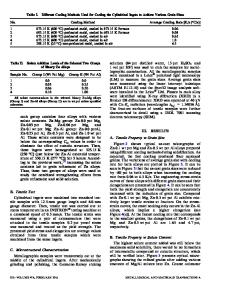Effect of gravity level on grain refinement in aluminum alloys
- PDF / 2,148,969 Bytes
- 6 Pages / 597 x 774 pts Page_size
- 62 Downloads / 338 Views
Effect of Gravity Level on Grain Refinement in Aluminum Alloys J.R. CAHOON, K.N. TANDON, and M.C. CHATURVEDI The grain refining effect of Ti in aluminum alloys has been known for over 40 years, m but the mechanism of refinement is still not fully understood. Theories of grain refinement by Ti additions can be categorized via one of three general mechanisms. (a) Heterogeneous nucleation from dendrites of A13Ti which form during solidification as a result of the peritectic reaction which occurs at concentrations above 0.15 wt pct Ti. I2'31It is proposed that pieces of dendrites are broken off and distributed throughout the melt as a result of convection mixing as nuclei for the growth of equiaxed grains. (b) A mechanism, proposed by N o r t h c o t t , ]41 which is akin to constitutional supercooling, whereby nucleation of equiaxed grains occurs in front of the solid-liquid interface. (c) Heterogeneous nucleation from undissolved substrate particles present in the grain-refining master alloy and which do not dissolve or dissolve only very slowly in molten aluminum, ts,6~ Grain refinement in aluminum has been summarized recently in an excellent review by McCartney. t71 The influence of natural convective mixing resulting from solidification in unit gravity on grain refinement via any of the proposed mechanisms has not been explicitly determined, but its possible influence has been emphasized in several investigations, t3,7-gj Presumably, the breaking of dendrites and their redistribution through the melt via convective mixing is the mechanism responsible for the grain refinement of tin at gravity levels above 3 G. tl21 Maxwell and Hellawell TM emphasize the importance of convective mixing to their model. Grain
J.R. CAHOON and M.C. CHATURVEDI, Professors, and K.N. TANDON, Associate Professor, are with the Metallurgical Sciences Laboratory, Department of Mechanical and Industrial Engineering, University of Manitoba, Winnipeg, MB, Canada R3T 2N2. Manuscript submitted April 11, 1991. METALLURGICAL TRANSACTIONS A
refinement via mechanism (b), constitutional supercooling, would also be affected by the degree of convective mixing, since temperature gradients would be affected. For mechanism (c), refinement as a result of pre-existing nuclei in the melt would be expected to be least affected by the degree of convective mixing. It is clear that convective mixing could play an influential role in the grain refining process and that investigations related to the effect of convective mixing would be beneficial in clarifying the mechanism of grain refinement. If convective mixing is a necessary factor for grain refinement, then castings solidified unidirectionally in unit or higher gravity (in the presence of convective mixing) should exhibit an equiaxed structure, whereas similar castings solidified unidirectionally in microgravity (in the absence of convective mixing) should exhibit a columnar structure. Therefore, an investigation was initiated to determine the effect of solidification in low gravity (where convective mixing
Data Loading...











